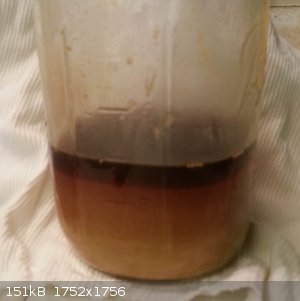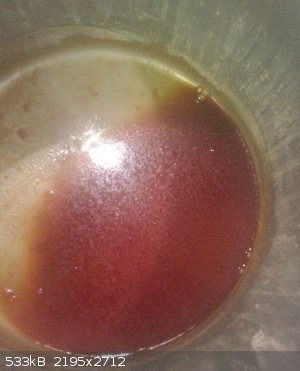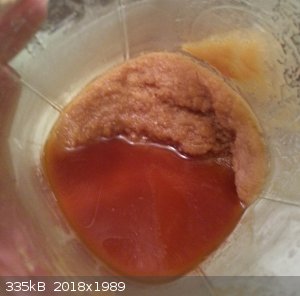RogueRose
International Hazard
    
Posts: 1585
Registered: 16-6-2014
Member Is Offline
|
|
Nitrates from Swiss or French method - Planning for a year long experiment - need suggestions & help!
Ok, well I've seen a lot of posts on here about people stating a nitrate salt (KNO3, Ca(NO3) and maybe NaNO3) can be made from urine or urine and
manure. It seems there is a wide range of how-to's and many seem to give contradictory steps.
Here is a quore on the Swiss and French method on the KNO3 page on Wiki:
| Quote: |
French method Niter-beds are prepared by mixing manure with either mortar or wood ashes, common earth and organic materials such as
straw to give porosity to a compost pile typically 4 feet (1.2 m) high, 6 feet (1.8 m) wide, and 15 feet (4.6 m) long.[17] The heap was usually under
a cover from the rain, kept moist with urine, turned often to accelerate the decomposition, then finally leached with water after approximately one
year, to remove the soluble calcium nitrate which was then converted to potassium nitrate by filtering through the potash.
Swiss method LeConte describes a process using only urine and not dung, referring to it as the Swiss method. Urine is collected
directly, in a sandpit under a stable. The sand itself is dug out and leached for nitrates which were then converted to potassium nitrate via potash,
as above. |
I have a 55 gallon steel drum as well as a 55gal polyetheleyne drum and I can use either for this. It's not 4ft tall, but it is 32" so it's not that
bad. I would suspect some production is possible.
I have access to very lively garden soil (lots of bacteria) and a field that has soybeans at the moment, so maybe the nitrogen fixating bacteria could
be harvested from the roots of these plants? Maybe mix the roots into the "slurry"?
I also have straw bales, bailed 2 months ago as well as some VERY dry (probably < 10% moisture) finely chopped grass clippings.
As far as manure, I live in a rural area and neighbors have cows, horses, chickens, ducks, turkey and others.
I will also have a good bit of access to oak ash (maybe some cherry & mulberry mixed in) this winter.
As far as urine, I think I will be stuck with using my own as I'm not harvesting from animals, lol . .
What I am not sure about is where it says that mortar or wood ashes are used in the french process. I guess this is for the Ca(OH)2 in the mortar and
K2CO3 in the ashes?
I did recently try to leach about 1 cubic ft of oak ash using de-ionized water from a dehumidifier drain. I used about 3 gallons of water then
filtered. I could not get the brown/red color out of the liquid but all particulate was removed down to a couple microns. This is what the result is
after boiling the filtrate down:
The top right image is of the liquid in the pan. I had allowed a portion of the liquid to evaporate and it seemed to form yellowish/clearish crystals
but they were very fragile and crumbled with slight pressure.
  
So I am wondering if the bottom of the drum should have some holes to allow for drainage. As the urine is poured in it will filter down through and
various compounds will accumulate and maybe the water will percolate through.
Also, would it be good to add more manure weekly/monthly - and which is best?
I've heard fermented urine may be better as it has fermented into ammonia.
Are there any additives which would be beneficial like LOTS of coffee grounds? I know they have a high nitrogen content and I have access to about
10gal per day if I wanted that.
My goal is to be able to make some gun powder for musket hunting and doing it the truly authentic way. I'll do a complete documentation of the
process if you guys are willing to give advice on what is the best way to do it.
The biggest concern is whether it needs to stay above freezing in the winter (will be tough). Maybe it will produce it's own heat and wrapping in
fiberglass insulation will help keep heat in.
|
|
|
Maroboduus
Hazard to Others
  
Posts: 257
Registered: 14-9-2016
Location: 26 Ancho Street
Member Is Offline
Mood: vacant
|
|
The Brown liquid from oak ashes needs roasting to eliminate organic residues. Dry it in a hot stove then put it in a crucible in the hot coals of a
fire. Not too much at once as it'll boil vigorously. Keep adding more as the boiling dies down until it's all in there and let it roast an hour or
two. When it's cool dig the material out and dissolve in water and filter. It will be freed from most of those organic contaminants. That's crude
Potash.
EDIT: firing crude potash is not a 'stinky' process. I have done it in my fireplace with no problem.
I don't know why you'd want that for making saltpeter, but it would be useful for making glass, or absolute ethanol, or potash biscuits(they used to
use it to leaven biscuits before saleratus got popular).
EDIT: Nitrogen fixing bacteria is ubiquitous in the environment. I use a huge biological filter to fix the nitrogen in a 3000 gallon fish pond. I
never seeded it with any bacteria, it just gets in there on its own. That thing must make a fair amount of nitrates, but boiling down all that water
just wouldn't be worth it. The urine and manure methods should make more concentrated solutions worth boiling down.
As an initial experiment it might be worth using some fully composted manure and leaching that. Or some high nitrate soil. It'd be a pity to do all
that futzing around with dung and urine for 6 months and not get a decent result, so why not see if the extraction works first?
[Edited on 28-9-2016 by Maroboduus]
[Edited on 28-9-2016 by Maroboduus]
|
|
|
Bert
|
Thread Moved
28-9-2016 at 13:01 |
aga
Forum Drunkard
    
Posts: 7030
Registered: 25-3-2014
Member Is Offline
|
|
I have an experient like this out on the land somewhere with a 10 gallon bucket.
It stinks to high heaven, which is probably why i forgot about it until now.
The Swiss method with horses will get an input of several gallons of pee per day, which is pretty much imposible to match by a single human, no matter
how much beer you drink.
Did i mention how much it stinks ?
Think i'll forget about it again.
|
|
|
ecos
Hazard to Others
  
Posts: 464
Registered: 6-3-2014
Member Is Offline
Mood: Learning !
|
|
how many gallons do this process need to get 100 gr of KNO3?
|
|
|
Marvin
National Hazard
   
Posts: 995
Registered: 13-10-2002
Member Is Offline
Mood: No Mood
|
|
Drums and buckets are a bad idea. Piles of earth/manure/urine/ash/limestone with straw and sticks and placed in layers are intended to let the air
circulate. If things go anaerobic nitrates get destroyed. It needs protecting from rain, but other than that it is best kept as open as possible.
Digging dirt under stables works but it's a much less sophisticated method.
I don't know the ins and outs of the Swiss method, but the same principles will apply for good conversion.
The bacteria in legumes that fixes atmospheric nitrogen is not the right sort. The best bacteria comes from soil around established outdoor
lavatories, from barns that are occupied by bats - that sort of thing.
|
|
|
Bert
Super Administrator
        
Posts: 2821
Registered: 12-3-2004
Member Is Offline
Mood: " I think we are all going to die. I think that love is an illusion. We are flawed, my darling".
|
|
Production of nitrate is a multi step process, carried out by several species of microorganisms. AND there are also microorganisms that will DEnitrify
under some circumstances, destroying the product you are looking to optimize extraction of.
Here's a start.
https://www.ncbi.nlm.nih.gov/pmc/articles/PMC3815407/
You may research this as a variety of historical/artisanal methods, or you may wish to look a bit deeper into the compost pile, perhaps you can do
better than all those 18th-19th century production workers- Who were pre-Pasteur, but highly experienced "rule of thumb" saltpeter men...
Rapopart’s Rules for critical commentary:
1. Attempt to re-express your target’s position so clearly, vividly and fairly that your target says: “Thanks, I wish I’d thought of putting it
that way.”
2. List any points of agreement (especially if they are not matters of general or widespread agreement).
3. Mention anything you have learned from your target.
4. Only then are you permitted to say so much as a word of rebuttal or criticism.
Anatol Rapoport was a Russian-born American mathematical psychologist (1911-2007).
|
|
|
Protium-1
Harmless

Posts: 4
Registered: 25-9-2016
Member Is Offline
Mood: No Mood
|
|
Its a cool project and there's no reason it shouldn't work. I remember my chem professor telling me that the detection of nitrate in well water is
often a bad thing because it indicates that animal dung is nearby and possibly contaminating the well with bacteria also.
My question though is, what is the point of doing an extraction of the wood ash? It seems to me that by using the whole ash to percolate your dung
compost extract through would act as a filter aid, similar to using Celite on top of a filter paper, and also an ion-echange medium which will release
its K+ ions and trap any passing through Ca2+ ions within the ash matrix as insoluble CaCO3.
I think that if you try to pass your dung compost extract through your obtained ash extract concentrate, you will end up with a layer of insoluble Ca
compounds on top which will severely hinder any more dung extract from passing through, essentially a clogged filter.
[Edited on 9-29-2016 by Protium-1]
|
|
|
aga
Forum Drunkard
    
Posts: 7030
Registered: 25-3-2014
Member Is Offline
|
|
Dung, Urine, Stench, Horses, Months of Effort .... or Ebay.
Sometimes the experience can be the same, but not often.
|
|
|
Maroboduus
Hazard to Others
  
Posts: 257
Registered: 14-9-2016
Location: 26 Ancho Street
Member Is Offline
Mood: vacant
|
|
Quote: Originally posted by aga  | I have an experient like this out on the land somewhere with a 10 gallon bucket.
It stinks to high heaven, which is probably why i forgot about it until now.
.......
Did i mention how much it stinks ?
|
My Great Uncle had an experiment like that too. Unfortunately he lived in a studio apartment.
About a month ago I collected the leavings from the bottoms of a few dozen rabbit cages (dung, newspaper, left over rabbit food all soaked with urine)
and put it in a 32 gallon trash can. I filled it 1/2 way with water and it's been fermenting and producing gas for the last month. This was just to
use the nutrients for gardening, but I'm gonna tap out a few gallons of the horrible brown liquid and boil it down and see if I can get anything like
nitrates out of it.
I also have a composter on site that gets all the kitchen refuse and some dried leaves as well as sludge from a 1200 gallon fish pond(A small one that
isn't hooked up to the biological filter). It's the kind of composter where you dump stuff in at the top, and dig the results out at the botton from a
trap door. I'm gonna try leaching some of the output from that as well. No crap or urine in the composter, unless that fish sludge counts, but rotten
worm eaten veg must have some nitrogen in it. .
Will report results if good or bad.
Probably gonna leach some ashes too and make potash. I've never actually tried that late 18th century potash biscuit recipe. (Note to the British and
other commonwealth types: these are American biscuits, fluffy hunks of cooked dough, not the twice cooked wafers you call biscuits)
Note to self: be careful not to confuse potash for biscuits with other 2 experiments.
|
|
|
RogueRose
International Hazard
    
Posts: 1585
Registered: 16-6-2014
Member Is Offline
|
|
I haven't read all the posts (wll later tonight or tomorrow) but it looks like a lot of good info. As for not sing a steel or plastic drum, that is
fine. I can make a square (2ft x 2ft x 4ft maybe?? or 30" x 30" x 48-60" tall) out of 1/4" thick wood strips 1-3" wide and space them to give air
flow. I can also line the inside or outside with something like chicken wire, wire mesh with 1/4 - 1/2" square's for the mesh, to hold smaller matter
inside the container.
This process isn't soley to obtain a nitrate, although that is the compound I wish to produce. The goal of the process is to do it and find out how
it works, how well, and how to make it better and what to avoid.
As for the ash water I boiled, that was simply to find out what soluble and possibly usable substances are available in wood ash. I had been making
soap and was always told mixing ashes with the oils then cooking will give soap, but found that difficult to believe, and other stories of leaching
lye from ash - so I decided to try myself and see what results I could obtain.
It is curious how in a chemistry forum that so many people "poo-poo" others experiments by saying "why not just buy it at (big box store) or online.
This process and many others like it are EXACTLY what should be promoted on this forum, especially for beginners as this type of thing is pretty safe.
Anyway, thanks for the info guys I look forward to reviewing the posts in-depth.
I'm still wondering which type of manure is ideal for this - chicken, turkey, duck or possibly horse, cow, pig, goat (human even??).
Finally with the addition of urine, would there be benefit of allowing it to ferment first before adding to the pile?
If all else fails in this process I will take whatever is in this barrel/container and till it into the garden - unless others see a reason why this
wouldn't be a good idea. The garden is 25x x 80ft (2,000 ft^2 or 222 yards ^2 0 so it is pretty big - IMHO)
Thanks again guys!
|
|
|
Marvin
National Hazard
   
Posts: 995
Registered: 13-10-2002
Member Is Offline
Mood: No Mood
|
|
Quote: Originally posted by Maroboduus  |
I filled it 1/2 way with water and it's been fermenting and producing gas for the last month. This was just to use the nutrients for gardening, but
I'm gonna tap out a few gallons of the horrible brown liquid and boil it down and see if I can get anything like nitrates out of it.
|
You will probably get some, but fermenting is an anaerobic process. It destroys nitrates. So the more it ferments the less you would expect.
RogueRose,
A lot of people prefer tidy, pleasant smelling small scale chemistry. It's a personal choice, but as soon as they can find someone that will sell
them nitrates they don't want to do experiments that will take them months and may attract the attention of the neighbours and the council air
pollution department.
|
|
|
Maroboduus
Hazard to Others
  
Posts: 257
Registered: 14-9-2016
Location: 26 Ancho Street
Member Is Offline
Mood: vacant
|
|
The term 'ferment' was used loosely and inaccurately. it has been undergoing decomposition. The material is wet and porous after it expanded from the
water added to it. It is in a loosely covered container (32 gallon bin) allowing air flow and does not have a strong ammonia odor. It DOES however
have an odd smell less fecal than earthy which while different than ordinary shit-stink, may be indicative of only partially broken down nitrogenous
organics. I only decided to tap some off at this time since the subject came up here. I actually have higher hopes for the fully cured compost I am
leaching, but am not sanguine about the potential yield of either.
I used the term ferment because the only thing I've submitted to large scale microbial digestion in a trash can before was mash sweetened with sugar
to make grappa.
I generally restrict myself to small scale organic chemistry, but wouldn't characterize it as pleasant smelling. Sure distilling essential oils and
making esters can be nice, but bromoacetone hardly qualifies. Even the act of opening a fresh bottle of Hydrochloric acid is a far from
pleasant-smelling experience. I don't mind diethyl ether, but tetrahydrofuran I find unpleasant.
Purines anybody?
As for the popular argument on this thread that 'someone will sell you nitrates';that applies equally well to just about every chemical made on this
board. Obviously just getting a package of the stuff in the mail isn't always the point.
There's 2,5 methoxy 4 methyl nitropropenylbenzene available right now on Ebay, but if somebody posted here saying they had just made some you would
not be likely to dismiss it by saying, "It's available on Ebay, go buy it" (although you might point out that it's a drug precursor that'll set off
alarm bells at the DEA).
As for the air pollution problem. There is a vast difference between the odor of a reasonable sized manure pile properly located and the reek of the
council flat next door where the neighbor went off the rails and started re-plastering the walls with his own fresh feces.
|
|
|